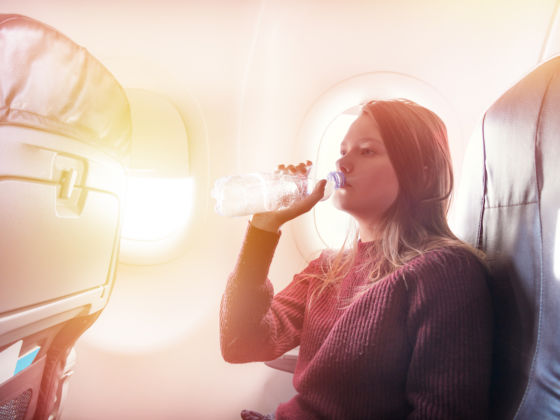Picture your last airplane experience. The movie selection was terrible, the food was even worse, and a subpar offering of booze was most definitely present — though you probably imbibed anyway. And to top it all off, there’s a good chance you were dehydrated. You can’t do anything about the first three issues, but there’s a clear reason as to why you were more parched than Spongebob in Sandy’s Dome.

Why You Get Dehydrated on a Flight and How to Prevent It
“Very few situations dehydrate a person in the same way that a flight does, aside from being in an arid area with little access to water,” Caleb Backe, a health and wellness expert for Maple Holistics, tells Matador Network. “If you do get very dehydrated, you might experience a headache, nausea, dizziness, or lethargy.”
Basically, it all comes down to air circulation. In order for people to fly as comfortably as possible at 35,000 feet up, the cabin needs to be pressurized, and fresh oxygen needs to be pumped in. That air is about as dry as it gets, sitting at around 10 to 20 percent humidity. The Sahara desert, for comparison, is around 25 percent humidity. This lack of moisture in the air, coupled with the stresses of travel that lead to perspiration, is a perfect storm for bodily dryness. And that in-flight booze you’re drinking to mentally make it through the voyage? That’s not helping either.
“Humidifying a cabin would seem a simple and sensible solution, but it’s avoided for different reasons,” Patrick Smith, a pilot and host of Ask the Pilot, tells Matador Network. “First, to amply humidify a jetliner would take large quantities of water, which is heavy and therefore expensive to carry. Humidifying systems would need to recapture and recirculate as much water as possible, making them expensive and complicated. (They do exist: One sells for more than $100,000 per unit and increases humidity only by a small margin.) There’s also the important issue of corrosion. Dampness and condensation leaching into the guts of an airframe can be damaging.”
Boeing is working on solving this problem with the Boeing 787, but the vast majority of planes are dry.
When your body is surrounded by dry air, moisture from your face (think nose, eyes, and throat) is drawn to the dry molecules around it, creating an evaporation-like effect on the body. Your body’s fluids are essentially being sucked out of you without you even doing anything. There’s nothing you can do to keep your body from dehydrating, but there are a couple ways to keep the dehydration somewhat at bay.
The Aerospace Medical Association recommends drinking eight ounces of water for every in-flight hour, especially on longer flights. Spacing out the water consumption is also key, as your body can’t fully take advantage of the liquid when you pound an entire bottle of water at once — not to mention the excessive bathroom visits.
Compensating for alcohol and caffeine is also key. RJ Oenbrink from Appalachian Wellness tells Matador Network that “both suppress the anti-diuretic hormone, which is responsible for allowing the kidneys to concentrate urine and conserve water.” So make sure to sip an eight-ounce glass of water alongside every boozy beverage to combat the dehydration you get from drinking.
Packing hydrating snacks, including fruits, veggies, and yogurt can also be helpful. And for the love of god, avoid snacking on excessive salty peanuts and pretzels, despite the fact that they’re free. And don’t forget your personal hydration station: lotion, lip balm, and a solid bottle of nasal spray — all under the three-ounce size limit, of course.